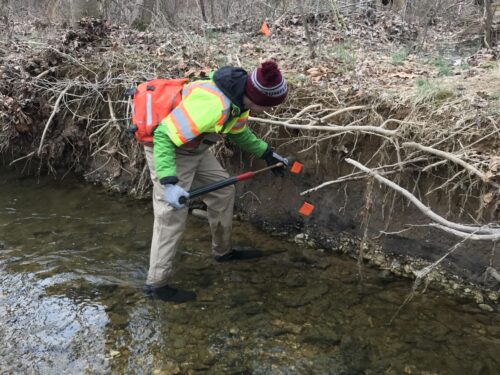Environmental Mitigation and Permitting
Environmental Mitigation and Permitting
Large scale stream and wetland restoration projects provide an opportunity to make substantial improvements in a watershed. The Patuxent Mitigation Bank is a stream and wetland restoration project located in Howard County, MD, that will restore and preserve approximately 11,750 linear feet of Cabin Branch and create, enhance, or preserve 28.25 acres of adjacent floodplain wetlands. JMT developed this restoration project because the site’s high ecological uplift potential provided an opportunity to make significant and measurable improvements within the Patuxent watershed.
The objectives of the Patuxent Mitigation Bank are to restore habitats for a variety of species, enhance the cold-water fishery, plant native vegetation and pollinator habitats, and improve the floodplain by reducing the overall flood intensity, depth, and velocity of water. JMT developed these objectives and collected data over a three-year period to formulate a design for the site. Data collected included a geomorphic assessment, BANCS analysis, soil nutrient data, rain and stream gauge installation and data analysis, stream functional pyramid evaluation, existing wetland and waterways analysis, forest stand delineation, soils investigation, full topographic survey, and habitat assessment for the stream, its tributaries, and adjacent floodplain areas. JMT also performed flow studies and monitored the fluctuation of water temperature within the stream at various locations. JMT engaged a key subconsultant who performed MBSS fish and benthic surveys at multiple locations within the project limits.
JMT coordinated with Maryland Department of Natural Resources (DNR) Fisheries to use this information to develop a design that preserves the high-quality tributary and creates the potential for an improved trout fishery throughout the rest of the site. Using this information, JMT prepared a stream health report. JMT worked with the landowners, the community, and multiple other stakeholders to clearly communicate the status of the project and to share information on the data collection as the project progressed. JMT staff hosted a virtual public meeting at which we presented an overview of the project, an update on the project schedule, and expectations that the local community should have for what construction would look like.
Since this project is a private restoration project and JMT is the project developer, JMT is responsible for the implementation of construction. JMT prepared construction documents, created a bid package, and oversaw a procurement process that allowed five short-listed construction firms to bid on this project. JMT will provide construction management services as well as designated specialist/construction oversight services.
JMT will provide long-term monitoring for a 10-year period, including fish and benthic surveys, invasive species monitoring and removal, geomorphic and habitat assessments, and tree and shrub monitoring.













